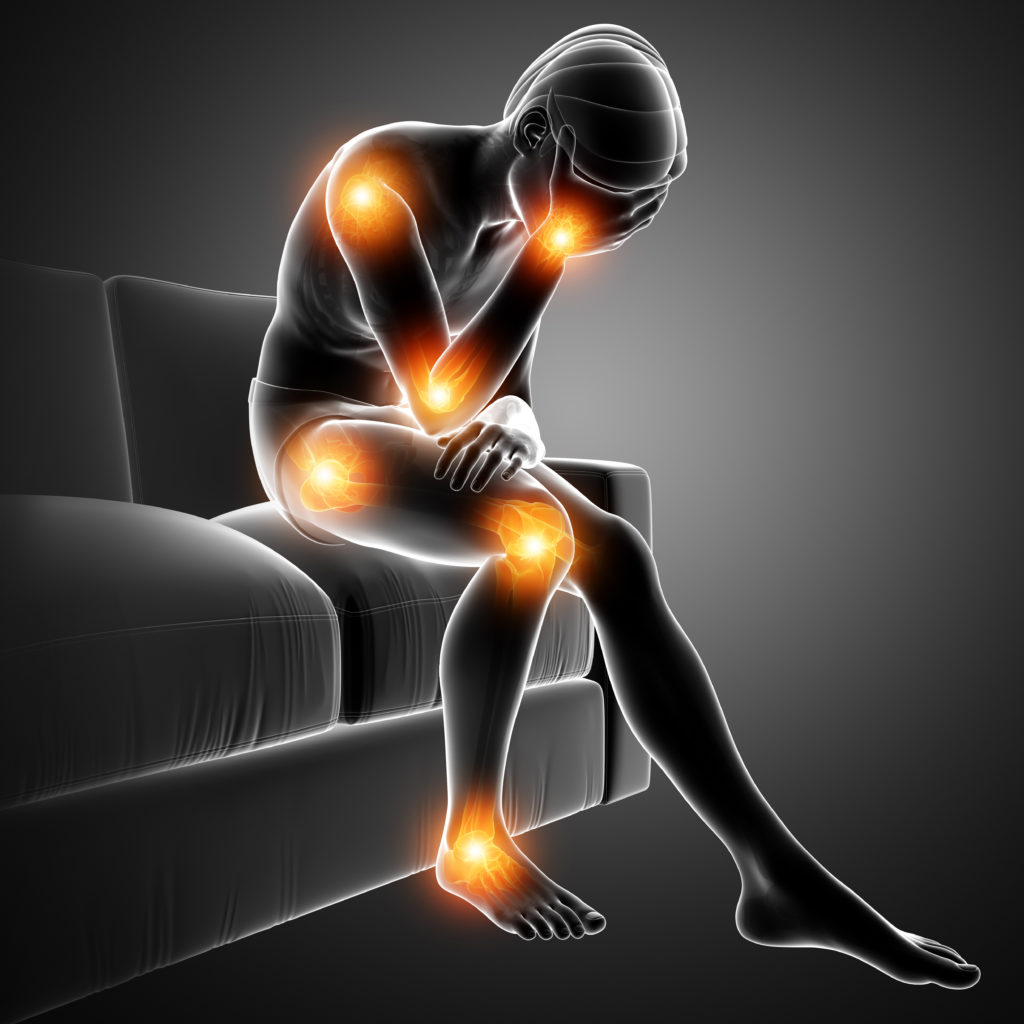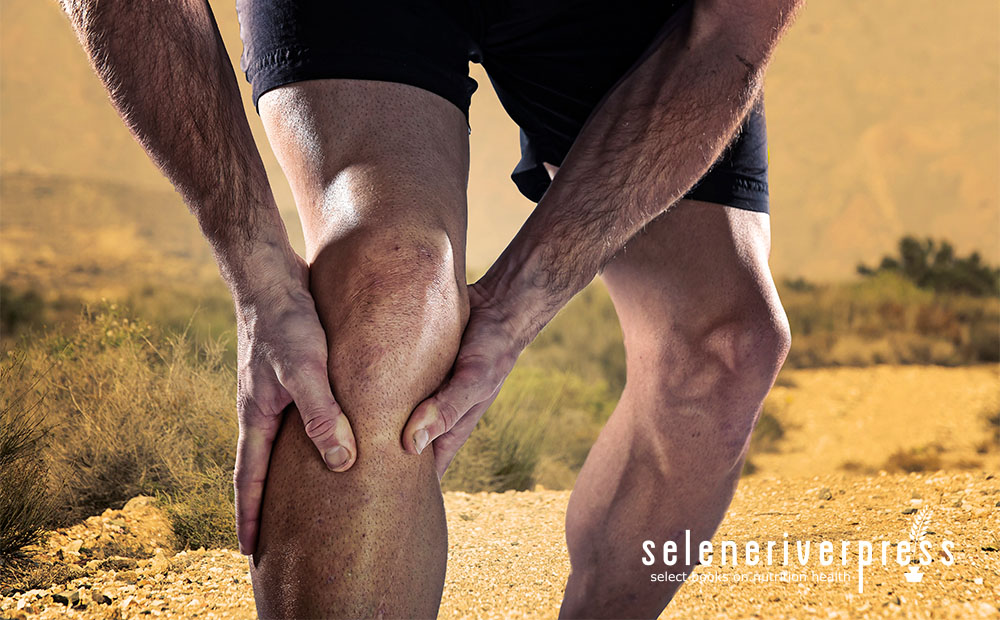It seems to me that even when we purposely research healthy foods and natural remedies, it’s sometimes just as easy to stumble into a unique healing solution as the result of a sudden illness. This is the situation I ran into recently after a sudden, unexpected episode of joint pain that made me feel like I might never walk again. Yes, both knees and one shoulder were in a very angry mode!
Providentially, I have a great go-to person who is very knowledgeable about the issue I was experiencing. She introduced me to alternative healing solutions that kept me from falling prey to the pharmaceutical merry-go-round of joint pain relief medications. The side effects from these drugs can be devastating, and the drugs do nothing to promote healing.
My adventure with sudden joint pain started with GLA, otherwise known as gamma-linolenic acid or gamma-linoleic acid. Hang in there as I outline the basics of GLA and introduce you to some products that have not only kept me free from pain but also promoted my healing.
What Is Gamma-Linolenic Acid?
Essentially, GLA is a polyunsaturated fatty acid. In order to give you a better understanding of this particular fatty acid, allow me to quote from an easy-to-understand article I found at the Weston A. Price Foundation titled “Gamma-Linoleic Acid,” by Mary Enig, PhD:
“The human body uses fatty acids from food for building tissues and for specialized functions such as the production of prostaglandins, localized tissue hormones. One major group of fatty acids is called essential fatty acids, which are polyunsaturated, and include two major groups, omega-3 and omega-6 fatty acids. They are called ‘essential’ because the body cannot make them but must get them from food.
“The terms omega-3 and omega-6 actually designate two families of fatty acids; the former has the first double bond on the third carbon from the end of the fatty acid chain and the latter has the first double bond on the sixth carbon from the end of the fatty acid chain. The first fatty acid in the omega-6 family is called linoleic acid. It contains 18 carbons and has 2 double bonds.” (Emphasis mine)
How Does Linoleic Acid Help Joint Pain?
VersusArthritis.org explains the following effect of linoleic acid in an article about blackcurrant seed oil:
“GLA is an essential fatty acid that’s important for maintaining a joint’s cell structure and function. Your body converts it into hormone-like substances called prostaglandins, which regulate your immune system and fight joint inflammation. GLA might also suppress inflammatory responses by directly acting on some inflammatory cells.”
Products I Now Use and Recommend
During the worst part of my joint episode, I started my treatment with the following three supplements. I’m happy to say that I experienced great improvement after only two weeks. You can get these products directly from any chiropractor or holistic physician who carries Standard Process products. (Click here to find a Standard Process practitioner near you.)
Warning: Do not buy these supplements online! You risk paying dearly for a product that may not be fresh or properly stored in a cool, dark environment. It may even be expired. Also keep in mind that when you are tested by a Standard Process practitioner, you are benefiting from their deep well of knowledge about the application and accuracy of dosages, which makes you more safe and secure in your healing process.
Here are the three supplements that helped me:
#1. Black Currant Seed Oil. This product is a cold-processed concentrate of the oil of black currant seeds. It’s a superior source of GLA because black currants are a food. Similarly, hemp oil isn’t a good source of GLA, unless it’s pure hemp seed oil. Long ago, when Dr. Royal Lee founded Standard Process, he set out to ensure that all SP supplements would be made from concentrated whole foods. But evening primrose is a noxious weed that requires a great deal of purification to extract its GLA. The same is true of any other nonfood source, such as the herb borage seed.
GLA provides the converted form of linolenic acid, which is normally produced by a healthy liver. In cases of eczema or severe dryness, the liver doesn’t convert essential fatty acid into the form used by the sebaceous glands under the skin. Now that many of us have been raised on hydrogenated fats found in margarine and most processed foods, healthy livers aren’t as common as they used to be. Additionally, GLA is a prostaglandin precursor. (But that’s another post!)
#2. Hemp Oil Complex. This product is especially helpful in inflammatory conditions. It’s specially designed to support the endocannabinoid system as well as the body’s natural inflammatory response function.
#3. Turmeric Forte. This product combines turmeric rhizome and fenugreek seed extracts to enhance absorption of curcuminoids, the active constituents of turmeric. Like the Hemp Oil Complex, it is also beneficial for inflammatory conditions.
But Wait—There’s More!
My go-to person explained what she suspected was the actual cause of my inflammatory condition and resulting joint pain. She then added two more supplements to my program. The first is simple and straight from Mother Nature: apple cider vinegar (ACV). Yes, as it turns out, acidification is the key.
Sudden joint pain is most commonly caused by a state of alkanity. In turn, an alkaline condition causes the calcium to move out of solution and into a solid state. These solidified calcium particles gravitate and settle into the joints. Very painful! Two or three tablespoons of ACV a day should do the trick.
But what could cause this sudden alkalinity? It turns out that the first thing to look for is low HCL levels in the stomach. For extra measure, add Standard Process Zypan to your meals to prevent too much alkalinity from beginning in the first place.
Once I connected all the dots, I was able to leave the house and shop for groceries for the first time in three weeks!
It’s important to remember that all SP supplements are sourced entirely from concentrated whole foods—they are not chemically or synthetically produced. It will therefore take a few days of steady, consistent dosages to flood your cells and start making a difference. We sometimes expect natural remedies to work like pharmaceuticals, but that’s not the case. Being a bit patient, I guarantee you, will lead to happier, healthier joints.
In closing, it’s obvious that as we age, especially if we have genetic joint issues, we must not (in my humble opinion) take the easy path of long-term ibuprofen usage. Rather, we must be very cautious about taking the pharmaceutical route because these short-term drugs may only compound the original problem with profound and negative side effects. They may have their place, but they cannot accomplish the most critical goal of all—addressing the cause of the problem. And as you can see here, that cause can be as simple as proper stomach digestive enzymes.
[xyz-ihs snippet=”Begin-Authors-Note”]Afterthoughts from the Traditional Cook
Some of the research on GLA effects is detailed in the Weston A. Price Foundation article I mentioned earlier, “Gamma-Linolenic Acid” by Mary Enig, PhD. The author writes:
“An excellent review of the beneficial effects of GLA was published in the Journal of Nutrition, 1998 (Vol. 128, No. 9, 1411–1414). Several studies have demonstrated the beneficial effects of GLA on rheumatoid arthritis… Said the authors: ‘The use of GLA as a benign, adjunctive therapy is relevant because rheumatoid arthritis patients are at high risk for developing complications from traditional nonsteroidal anti-inflammatory drug and corticosteroid medications’…
“GLA is unique among the omega-6 family in its ‘potential to suppress tumor growth and metastasis.’ Other studies report very favorable results in the treatment of diabetic neuropathy with GLA…
“Several studies involving rats have indicated that GLA can have a favorable effect on blood pressure. Also, in one human study, carried out in France, it was found the GLA not only lowered blood pressure but had a favorable effect on other cardiovascular risk factors (Bratisl Lek Listy, 2002, 103(3):101–7)…
“Finally, GLA has been shown to encourage weight loss in individuals who are considerably overweight, making it a good aid for dieting (David F. Horrobin, ed. Clinical Uses of Essential Fatty Acids. Montreal: Eden Press, pp. 53–61, 1982).”
[xyz-ihs snippet=”End-Authors-Note”]Note from Maria: I am a Certified Natural Health Professional, CNHP, not a medical doctor. I do not diagnose, prescribe for, treat, or claim to prevent, mitigate, or cure any human diseases. Please see your medical doctor prior to following any recommendations I make in my blogs or on my website.
Images from iStock/OcusFocus (main), sankalpmaya (joint pain), bhofack2 (vinegar), Magone (black currant).





